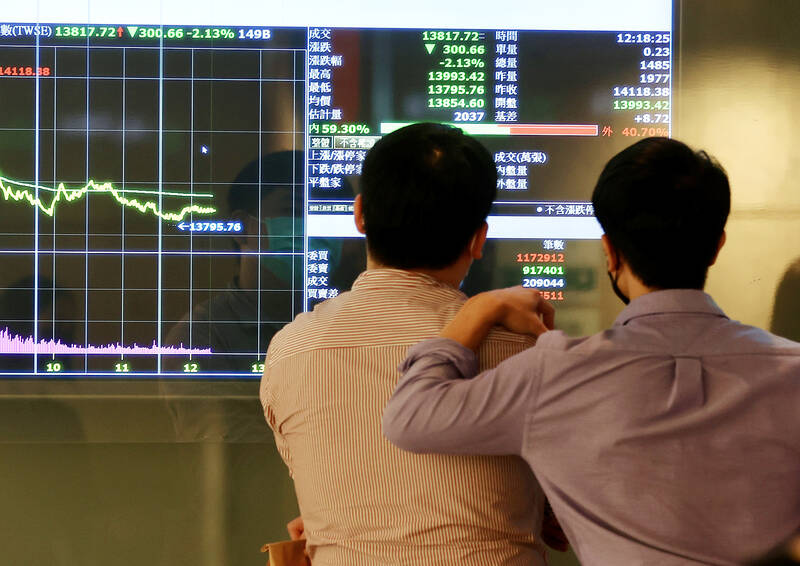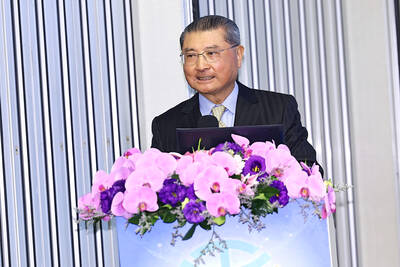The TAIEX yesterday plunged 2.41 percent to close at 13,778.19 points in a sell-off triggered by Friday’s losses on Wall Street amid concerns over US Federal Reserve rate hikes.
The index lost 340.19 points. Turnover totaled NT$217.81 billion (US$6.84 billion), with foreign institutional investors selling a net NT$7.85 billion of shares on the main board, Taiwan Stock Exchange data showed.
Declines in the bellwether electronics sector weighed on the market. Rising interest rates tend to pull investors away from dividend-paying tech stocks.

Photo: CNA
Old-economy and financial stocks also came under heavy selling pressure, pushing the TAIEX below the nearest technical resistance level of 13,928 points, which was the intraday low on July 12.
“As the TAIEX failed to sustain itself above 13,928 points today, the main board has become technically fragile,” MasterLink Securities Corp (元富證券) analyst Tom Tang (湯忠謙) said. “The weakness simply reflects worries that the Fed will continue to act aggressively after a 75-basis-point rate hike in September.”
Fed Chairman Jerome Powell on Wednesday said that he and his colleagues were “strongly committed to bringing inflation back down to our 2 percent goal.”
Meanwhile, the “dot plot” which the Fed uses to signal its outlook for the path of interest rates, indicated there would be no rate cuts until 2024.
Last month, the US consumer price index rose 8.3 percent, moderating from 8.5 percent in July, but beat a market estimate of 8.1 percent.
“The rate hike cycle in the US continues to prompt foreign institutional investors to cut their holdings. And liquid tech heavyweights, again, fell victim to the sell-off, despite government intervention,” Tang said.
The electronics sector lost 2.42 percent, with the semiconductor sub-index falling 2.42 percent. The transportation sector led old economy stocks lower throughout the session, plunging 6.15 percent.
“Selling among shipping stocks was sparked by falling freight rates at a time when a weakening global economy dragged down demand,” Tang said, referring to the Shanghai Containerized Freight Index, which fell more than 11 percent on Friday.
The financial sector lost 1.62 percent, the construction sector dropped 2.91 percent, the steel sector fell 3.31 percent, and the biotechnology and medical care sector lost 4.02 percent.
“As the Dow Jones Industrial Average fell below 30,000 points, more losses are likely to follow and continue to affect sentiment in Taiwan,” Tang said. “So, it is hard to predict where the TAIEX will find the next nearest technical support.”

When an apartment comes up for rent in Germany’s big cities, hundreds of prospective tenants often queue down the street to view it, but the acute shortage of affordable housing is getting scant attention ahead of today’s snap general election. “Housing is one of the main problems for people, but nobody talks about it, nobody takes it seriously,” said Andreas Ibel, president of Build Europe, an association representing housing developers. Migration and the sluggish economy top the list of voters’ concerns, but analysts say housing policy fails to break through as returns on investment take time to register, making the

‘SILVER LINING’: Although the news caused TSMC to fall on the local market, an analyst said that as tariffs are not set to go into effect until April, there is still time for negotiations US President Donald Trump on Tuesday said that he would likely impose tariffs on semiconductor, automobile and pharmaceutical imports of about 25 percent, with an announcement coming as soon as April 2 in a move that would represent a dramatic widening of the US leader’s trade war. “I probably will tell you that on April 2, but it’ll be in the neighborhood of 25 percent,” Trump told reporters at his Mar-a-Lago club when asked about his plan for auto tariffs. Asked about similar levies on pharmaceutical drugs and semiconductors, the president said that “it’ll be 25 percent and higher, and it’ll

CHIP BOOM: Revenue for the semiconductor industry is set to reach US$1 trillion by 2032, opening up opportunities for the chip pacakging and testing company, it said ASE Technology Holding Co (日月光投控), the world’s largest provider of outsourced semiconductor assembly and test (OSAT) services, yesterday launched a new advanced manufacturing facility in Penang, Malaysia, aiming to meet growing demand for emerging technologies such as generative artificial intelligence (AI) applications. The US$300 million facility is a critical step in expanding ASE’s global footprint, offering an alternative for customers from the US, Europe, Japan, South Korea and China to assemble and test chips outside of Taiwan amid efforts to diversify supply chains. The plant, the company’s fifth in Malaysia, is part of a strategic expansion plan that would more than triple

Taiwanese artificial intelligence (AI) server makers are expected to make major investments in Texas in May after US President Donald Trump’s first 100 days in office and amid his rising tariff threats, Taiwan Electrical and Electronic Manufacturers’ Association (TEEMA, 台灣電子電機公會) chairman Richard Lee (李詩欽) said yesterday. The association led a delegation of seven AI server manufacturers to Washington, as well as the US states of California, Texas and New Mexico, to discuss land and tax issues, as Taiwanese firms speed up their production plans in the US with many of them seeing Texas as their top option for investment, Lee said. The